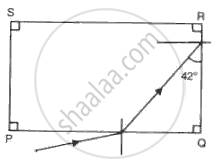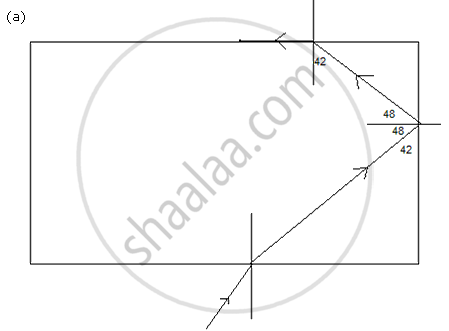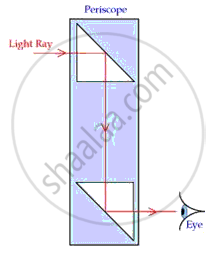Advertisements
Advertisements
प्रश्न
(a) A ray of monochromatic light enters glass PQRS as shown in the fig. Complete the path of ray till it emerges from the glass. (Critical angle of glass is 420).

(b) Draw diagram of a prism periscope.
(c) What are the advantages of total internal reflecting prism over plane mirror?
उत्तर

Note : here that when the angle of incidence in the denser medium is more than the critical angle (= 42), then the ray undergoes total internal reflection.
At angle of incidence equal to critical angle, the ray grazes the interface.
(b) Diagram of prism periscope:

(c) In case of reflection from plane mirror, all of light in not reflected. In case of total reflecting prism, all rays failing beyond critical angle will be totally reflected. The intensity of reflected light is equal to the intensity of incident light in case of total internal ref;lection but not in case of reflection from plane mirror.
In addition, the reflection through a thick mirror causes multiple image formation as well as lateral inversion of image.
Due to the above two reasons, the total reflecting prisms are preferred over the plane mirrors.
APPEARS IN
संबंधित प्रश्न
State two conditions necessary for total internal reflection to occur.
Prove the statement.
A rainbow is the combined effect of the refraction, dispersion, and total internal reflection of light.
How does a ray of light bend when it travels from when it is normal to the interface of the two media.
A ray of light is incident as a normal ray on the surface of separation of two different mediums. What is the value of the angle of incidence in this case?
Which of the following is not involved in formation of a rainbow?
Critical angle of light passing from glass to air is maximum for ____________.
The outer concentric shell in optic fiber is called ______.
The angle of incidence at which the angle of refraction is Q£ is called the critical angle.
A Rainbow is a beautiful natural phenomenon formed because of the following:
